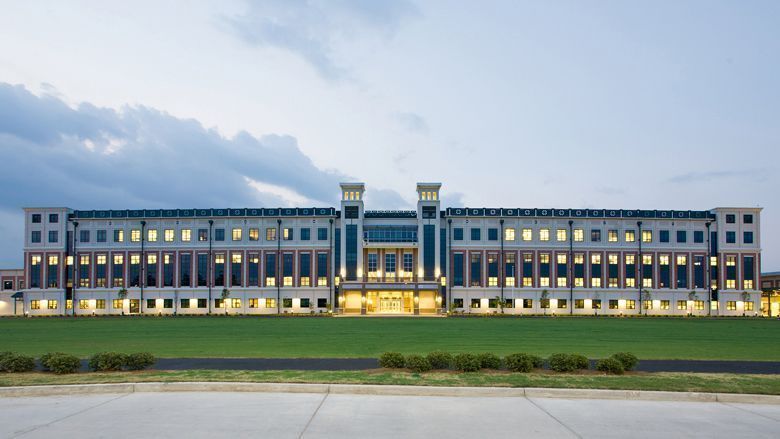Top 10 Tilt-Up Building Designs Across North America

In North America, Tilt-Up construction is most closely associated with warehousing. The method’s reputation for combining speed and safety with cost-savings, durability and energy efficiency has made it a popular choice for the industrial and commercial market from coast to coast.
But for architects, Tilt-Up offers a wide palette of creative design options. Those who familiarize themselves with the method soon learn that site-cast concrete can build much more than big-box structures.
Here are ten diverse projects from across North America that showcase what Tilt-Up can do, both in terms of form and function.
[ultimate_carousel title_text_typography=”” slides_on_desk=”1″ slides_on_tabs=”1″ slides_on_mob=”1″][vc_single_image image=”4239″ img_size=”800×450″][vc_single_image image=”4290″ img_size=”800×450″][vc_single_image image=”4291″ img_size=”800×450″][/ultimate_carousel]
1. Broadview Public School
Location: Ottawa, Ontario
Description: Located in the heart of an urban neighborhood, Broadview Public School was a complex job with an aggressive construction timeline. Most of the tilt-up panels were poured and lifted during the winter months. The architect designed the building to showcase the creative options offered by concrete. The school’s exterior features a variety of finishes, from beautiful and bold imprints to traditional brick veneer. In addition, the use of insulated tilt-up sandwich panels allowed for an energy efficient school at costs that rival traditional construction methods.
Project Details:
- Contractor: Frecon Construction Ltd.
- Architect: Edward J. Cuhaci and Associates Architects Inc.
- Engineer: Cunliffe and Associates
- Building size: 42,951 sq ft, 2 storey, total building area 74,973 sq ft
- Building use: elementary school
- Heaviest panel: 85,200 lbs
- Tallest panel: 35’-9”
- Largest panel: 1,080 sq ft
Project Profile: Broadview Public School
[ultimate_carousel title_text_typography=”” slides_on_desk=”1″ slides_on_tabs=”1″ slides_on_mob=”1″][vc_single_image image=”4240″ img_size=”800×450″][vc_single_image image=”4313″ img_size=”800×450″][vc_single_image image=”4317″ img_size=”800×450″][/ultimate_carousel]
2. Prologis Stapleton Business Center Building 1
Location: Denver, CO, United States
Description: This spec warehouse demonstrates tilt-up’s ability to merge function and design. The building incorporates several architectural tilt-up features including lay-up panels, floating panels and spandrels that span more than 50-feet. All four corners of the building incorporate three-story recessed storefront glass, covered canopies, floating panels, and bearing spandrels that frame into adjacent spandrel panels. These complex corners required careful planning and erection, and give the building it’s striking appearance.
Project Details:
- Contractor: KB Concrete Systems, Inc.
- Architect: Ware Malcomb
- Engineer: Peak Engineering, Inc.
- Project Floor Area: 392,425 sq ft
- Building use: Warehouse/Distribution Division
- Heaviest panel: 130,430 lbs
- Tallest panel: 50 ft 6 in
- Largest panel: 1,395 sq ft
Project Profile: Prologis Stapleton Business Center Building 1
[ultimate_carousel title_text_typography=”” slides_on_desk=”1″ slides_on_tabs=”1″ slides_on_mob=”1″][vc_single_image image=”4241″ img_size=”800×450″][vc_single_image image=”4309″ img_size=”800×450″][vc_single_image image=”4310″ img_size=”800×450″][/ultimate_carousel]
3. Marine Corps Support Facility
Location: New Orleans, LA, United States
Description: As the national headquarters for the Marine Forces Reserve, this secure installation includes a four-story main building, a two-story band annex, a detached warehouse and a multi-purpose parade ground for music and military exercises.
The project required more than 190 tilt-up wall panels, including panels as tall as 72 feet high and weighing as much as 130,000 pounds.
This building is one of the first buildings to use exterior tilt-up wall panels to fulfill progressive collapse avoidance requirements for military facilities. Structurally, it is designed to meet anti-terrorism and force protection criteria, federal blast standards and emergency readiness standards. Based on the location, the facility is designed to meet hurricane protection criteria.
Tilt-Up construction provided cost savings of around $2 million and saved three months of construction time.
Project Details:
- Contractor: Woodward Design+Build, LLC
- Architect: Mathes Brierre
- Engineer: LJB Inc.
- Project Floor Area: 417,000 sq ft
- Building use: Office Division
- Heaviest panel: 141,000 lbs
- Tallest panel: 72 ft 6 in
- Longest Spandrel Panel: 35 ft 8 in
Project Profile: Marine Corps Support Facility
[ultimate_carousel title_text_typography=”” slides_on_desk=”1″ slides_on_tabs=”1″ slides_on_mob=”1″][vc_single_image image=”4242″ img_size=”800×450″][vc_single_image image=”4296″ img_size=”800×450″][vc_single_image image=”4304″ img_size=”800×450″][/ultimate_carousel]
4. Crossroads Christian Church Children’s Building
Location: Grand Prairie, United States
Description: Crossroads’ Christian Church Children’s Building is a 75,000-square-foot, two story facility featuring a 450-seat theatre with stadium seating, a gymnasium, snack bar, ice cream shop, gaming stations, and an indoor, two-level park-themed play space.
It also features 17 large classrooms, administrative offices, commercial kitchen and a first floor ‘main street.’
The building’s colourful art deco design was intended to appeal to children and create a space where they would feel welcome and included.
Project Details:
- Project Floor Area: 70,000 sq ft
- Building use: Spiritual Division
- Heaviest panel: 70,000 lbs
- Tallest panel: 58 ft 0 in
- Largest panel: 2,700 sq ft
Project Profile: Crossroads Christian Church Children’s Building
[ultimate_carousel title_text_typography=”” slides_on_desk=”1″ slides_on_tabs=”1″ slides_on_mob=”1″][vc_single_image image=”4312″ img_size=”800×450″][vc_single_image image=”4243″ img_size=”800×450″][vc_single_image image=”4311″ img_size=”800×450″][/ultimate_carousel]
5. Overbeek Residence
Location: Woodstock, Ontario
Description: From the outside, the 6-bedroom, and 2,900 sq. ft. house is indistinguishable from a conventionally-built residence. But Ontario’s first tilt-up home is more than 30 per cent more energy-efficient than a traditional wood-frame house.
That’s because tilt-up construction uses R20 continuous sandwich panel construction without any thermal bridging, making a concrete home much more energy-efficient than a wood-frame house.
Tilt-up construction is already being used for residential projects in the US and on Canada’s West Coast. After the success of this first residential project in Ontario, the Tilt-Up method is ready to make it’s mark in the provinces’ residential sector as well.
Project Details:
- Architect: Len Overbeek (Owner)
- Building size: 4,100 square feet for the ground floor including garage
- Building use: Residence
- Heaviest panel: 78,000 lbs
- Tallest panel: 38’ – 10”
- Largest panel: 879 square feet
- Other interesting points: This home is the first Residential Site Cast Tilt-Up Project in Ontario.
Project Profile: Overbeek Residence
[ultimate_carousel title_text_typography=”” slides_on_desk=”1″ slides_on_tabs=”1″ slides_on_mob=”1″][vc_single_image image=”4244″ img_size=”800×450″][vc_single_image image=”4307″ img_size=”800×450″][vc_single_image image=”4308″ img_size=”800×450″][/ultimate_carousel]
6. Louis Premium Outlets
Location: Chesterfield, United States
Description: This large-scale outlet mall consisted of eight buildings, totally 376,000-square-feet of slab concrete and 214,000-square-feet of Tilt-UP panels.
Tilt-Up was selected as the construction method of choice because it is the fastest, most cost effective, high quality, and safe way to construct a load bearing wall system. Due to a tight construction schedule, a simple Tilt-Wall panel system was used. Exterior architectural elements were applied to the buildings post-construction.
The project generated significant interest from the media and general public and opened the door for Tilt-Up design and construction in the region.
Project Details:
- Contractor: Concrete Strategies, Inc.
- Engineer: Needham and Associates, Inc.
- Project Floor Area: 380,000 sq ft
- Building use: Retail Division
- Heaviest panel: 75,000 lbs
- Tallest panel: 27 ft 0 in
- Largest panel: 600 sq ft
Project Profile: Louis Premium Outlets
[ultimate_carousel title_text_typography=”” slides_on_desk=”1″ slides_on_tabs=”1″ slides_on_mob=”1″][vc_single_image image=”4245″ img_size=”800×450″][vc_single_image image=”4315″ img_size=”800×450″][vc_single_image image=”4316″ img_size=”800×450″][/ultimate_carousel]
7. Warren Theatre – Broken Arrow
Location: Broken Arrow, United States
Description: Inspired by the glamour of Hollywood art deco, the Warren Theatre features rich architectural features and vibrant colours. As well as being one of the most elaborate movie theatres in the US, the $20 million project is also the country’s largest, with 18 cinema screens.
The exterior walls of the auditorium ‘wings’ and the taller central core structure utilized load-bearing Tilt-Up panels.
One of the projects structural highlights is the 81’-2” wide spandrel panel behind the marquee tower spanning over the main entry. Due to its size, the panel required a coordinated two-crane lift. This spandrel is a significant load-bearing element of the structure as it supports roof joists on the backside as well as two levels of steel framing for the marquee tower on the front.
The panel spans 77’ clear over the open lobby with a bearing height of 45’ above finish floor, requiring special bracing consideration for construction loads and erection sequencing.
Project Details:
- Project Floor Area: 150,000 sq ft
- Building use: Commercial Division
- Heaviest panel: 133,300 lbs
- Tallest panel: 58 ft 2 in
- Largest panel: 1,194 sq ft
Project Profile: Warren Theatre – Broken Arrow
[ultimate_carousel title_text_typography=”” slides_on_desk=”1″ slides_on_tabs=”1″ slides_on_mob=”1″][vc_single_image image=”4246″ img_size=”800×450″][vc_single_image image=”4295″ img_size=”800×450″][vc_single_image image=”4320″ img_size=”800×450″][/ultimate_carousel]
8. Commerce Way
Location: Woodstock, Ontario
Description: The building is multi-tenanted, and the design incorporates unique architectural design for each suite. The creation of three distinct frontages allowed three different Tilt-Up solutions to be showcased.
The first tenant (the design builder) had the concrete take on a balancing act with the leading edge pushed beyond the building footprint. Additional form liners were used on the side and rear elevations, and the interior spaces to show clients the many options available for their own projects.
The second tenant requested a more traditional facade treatment, which was achieved with a varied response of masonry veneer.
The third tenant space allowed the design builder to create a facade that employed the use of suspended “keystone” panel.
The building’s sign pylon was also made with Tilt-Up and reflects the design ethos of the main building.
Project Details:
- Owner: Orangewood Holdings
- Architect: Barry-Bryan Associates
- Engineer: Barry-Bryan Associates
- Building size: 9,900 square feet for the ground floor
- Building use: mixed office and light commercial
- Heaviest panel: 82,100 lbs
- Tallest panel: 29’-4”
- Largest panel: 946 square feet
Project Profile: Commerce Way
[ultimate_carousel title_text_typography=”” slides_on_desk=”1″ slides_on_tabs=”1″ slides_on_mob=”1″][vc_single_image image=”4247″ img_size=”800×450″][vc_single_image image=”4305″ img_size=”800×450″][vc_single_image image=”4306″ img_size=”800×450″][/ultimate_carousel]
9. Daikin Texas Technology Park
Location: Waller, TX, United States
Description: With over four-million operational square feet, Daikin Texas Technology Park is the largest Tilt-Up concrete structure in the world. More than 350,000 cubic yards of concrete were poured to cast 428 panels measuring more than two miles in length.
The new state-of-the art business campus consolidates many of the company’s HVAC manufacturing and logistics facilities across North America., and brings research and development, manufacturing, engineering, logistics, marketing, distribution, and sales operations under one roof.
The building was designed from the ground up with energy-efficiency and employee comfort in mind and features high efficiency LED lighting throughout as well as high-efficiency climate control equipment. It also reclaims 96% of process water.
Project Details:
- Contractor: D.E. Harvey Builders
- Architect: Powers Brown Architecture
- Engineer: LJB Inc.
- Project Floor Area: 4,226,749 sq ft
- Building use: Manufacturing/Industrial Division
- Heaviest panel: 200,600 lbs
- Tallest panel: 59 ft 7 in
- Longest Spandrel Panel: 61 ft 3 in
Project Profile: Daikin Texas Technology Park
[ultimate_carousel title_text_typography=”” slides_on_desk=”1″ slides_on_tabs=”1″ slides_on_mob=”1″][vc_single_image image=”4248″ img_size=”800×450″][vc_single_image image=”4293″ img_size=”800×450″][vc_single_image image=”4292″ img_size=”800×450″][/ultimate_carousel]
10. Cedar Ridge High School
Location: Round Rock, United States
Description: This stunning building was created by blending tilt-up concrete walls with masonry, metal panels, aluminum, glass, plaster and paint.
Tilt-up was used structurally to facilitate the architectural finishes while keeping costs in check. For example, to accommodate the gymnasium’s large windows, roof joists were originally designed to bear on structural steel behind the tilt-up wall. However, a redesign eliminated the majority of the steel. Instead, the joists were supported by the panels, reducing interference of the columns with the folding bleacher sections along that wall. In addition, Tilt-up panels were used as supports for four large “flyovers,” composed of large steel beams and joists, which sit 40 feet above the courtyard.
By recycling concrete into special containers and on-site casting beds, the contractor was able to divert 89 percent of its construction waste from landfills. That, combined with the fact that the concrete supplied for the project came from plants within a 20-mile radius of the construction site, has the school on track to achieve LEED Silver Certification.
Project Details:
- Contractor: American Constructors LP
- Project Floor Area: 170,000 sq ft
- Building use: Educational Division
- Heaviest panel: 129,100 lbs
- Tallest panel: 39 ft 7 in
- Largest panel: 1,282 sq ft
Project Profile: Cedar Ridge High School

